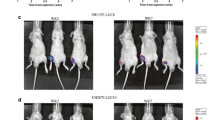Abstract
Chondroblastoma (CBL) is a benign bone tumor occurring mostly in teenagers. Despite this, CBL can recur and metastasize after curettage, which may impede normal epiphysis. In search of a novel targeted therapy for CBL, we aimed at BMP-2, a factor critical for chondro-osteogenesis and chondrocyte proliferation. Two pathways upstream of BMP-2, the mTOR and HIF, were targeted with rapamycin (Rapa) and FM19G11 (FM), respectively. Using immunohistochemistry, we found BMP-2 was highly expressed in CBL tissues. CBL cells explanted and confirmed with higher BMP-2 level than normal cartilage. Protumorigenic effect of Rapa and FM on CBL cells were transduced via BMP-2. Combination of Rapa and FM conferred stronger inhibition of cell proliferation than either monotherapy and inhibited levels of chondro-osteogenic markers (Sox9, aggrecan, and type II collagen). To minimize the adverse effect of Rapa, we performed screening in essential amino acids and found leucine deprivation-sensitized CBL cells to Rapa. Combination treatment of low dose Rapa, FM, and leucine deprivation conferred compatible inhibitory effects on CBL cell proliferation, chondro-osteogenic potential, and tumorigenic capacity. We conclude that targeting BMP-2 using mTOR/HIF inhibition could potently curb the disease. Addition of low-leucine diet could lower the dose of rapamycin in chase for less toxicity.




Similar content being viewed by others
References
Schajowicz F, Gallardo H. Epiphysial chondroblastoma of bone. A clinico-pathological study of sixty-nine cases. J Bone Joint Surg Br. 1970;52:205–26.
Dahlin DC, Ivins JC. Benign chondroblastoma. A study of 125 cases. Cancer. 1972;30:401–13.
Jaffe HL, Lichtenstein L. Chondromyxoid fibroma of bone; a distinctive benign tumor likely to be mistaken especially for chondrosarcoma. Arch Pathol (Chicago). 1948;45:541–51.
Lin PP, Thenappan A, Deavers MT, Lewis VO, Yasko AW. Treatment and prognosis of chondroblastoma. Clin Orthop Relat Res. 2005;438:103–9.
Ramappa AJ, Lee FY, Tang P, Carlson JR, Gebhardt MC, Mankin HJ. Chondroblastoma of bone. J Bone Joint Surg Am. 2000;82-A:1140–5.
Springfield DS, Capanna R, Gherlinzoni F, Picci P, Campanacci M. Chondroblastoma. A review of seventy cases. J Bone Joint Surg Am. 1985;67:748–55.
Ilaslan H, Sundaram M, Unni KK. Vertebral chondroblastoma. Skeletal Radiol. 2003;32:66–71.
Jaffe HL, Lichtenstein L. Benign chondroblastoma of bone: a reinterpretation of the so-called calcifying or chondromatous giant cell tumor. Am J Pathol. 1942;18:969–91.
Sailhan F, Chotel F, Parot R, SOFOP. Chondroblastoma of bone in a pediatric population. J Bone Joint Surg Am. 2009;91:2159–68.
Maheshwari AV, Jelinek JS, Song AJ, Nelson KJ, Murphey MD, Henshaw RM. Metaphyseal and diaphyseal chondroblastomas. Skeletal Radiol. 2011;40:1563–73.
Yang ZJ, Liu FX, Yang YS, Yang X, Zhu GX. Expression of bone-morphogenetic protein 2 and tumor necrosis factor α correlates with bone metastases in bladder urothelial carcinoma. Ann Diagn Pathol. 2013;17:51–3.
Yang X, Wang YP, Liu FX, Zeng K, Qian MQ, Chen G, et al. Increased invasiveness of osteosarcoma mesenchymal stem cells induced by bone-morphogenetic protein-2. In Vitro Cell Dev Biol Anim. 2013;49:270–8.
Robinson D, Lewis MM, Nevo Z, Kenan S, Einhorn TA. The radiographic stage of giant cell tumor related to stromal cells’ proliferation. Tissue cultures in 13 cases. Acta Orthop Scand. 1997;68:294–7.
Feng C, Guan M, Ding Q, Zhang Y, Jiang H, Wen H, et al. Expression of pigment epithelium-derived factor in bladder tumour is correlated with interleukin-8 yet not with interleukin-1α. J Huazhong Univ Sci Technolog Med Sci. 2011;31:21–5.
Guo T, Gu C, Feng C, Ding Q, Xu C, Li B. Endoureterotomy is not a sufficient treatment for intrinsic ureteral endometriosis. Videosurgery Miniinv. 2013. doi:10.5114/wiitm.2011.33614.
Wen H, Feng CC, Ding GX, Meng DL, Ding Q, Fang ZJ, et al. Med19 promotes bone metastasis and invasiveness of bladder urothelial carcinoma via bone morphogenetic protein 2. Ann Diagn Pathol. 2012. doi:10.1016/j.anndiagpath.2012.11.004.
Feng CC, Wang PH, Ding Q, Guan M, Zhang YF, Jiang HW, et al. Expression of pigment epithelium-derived factor and tumor necrosis factor-α is correlated in bladder tumor and is related to tumor angiogenesis. Urol Oncol. 2013;31:241–6.
Feng CC, Ding Q, Zhang YF, Jiang HW, Wen H, Wang PH, et al. Pigment epithelium-derived factor expression is down-regulated in bladder tumors and correlates with vascular endothelial growth factor and matrix metalloproteinase-9. Int Urol Nephrol. 2011;43:383–90.
Feng CC, Wang PH, Guan M, Jiang HW, Wen H, Ding Q, et al. Urinary BLCA-4 is highly specific for detection of bladder cancer in Chinese Han population and is related to tumour invasiveness. Folia Biol (Praha). 2011;57:242–7.
Karsenty G. The complexities of skeletal biology. Nature. 2003;423:316–8.
Martin KA. Blenis J, Coordinate regulation of translation by the PI 3-kinase and mTOR pathways. Adv Cancer Res. 2002;86:1–39.
Martin DE, Hall MN. The expanding TOR signaling network. Curr Opin Cell Biol. 2005;17:158–66.
Kimball SR, Jefferson LS. Signaling pathways and molecular mechanisms through which branched-chain amino acids mediate translational control of protein synthesis. J Nutr. 2006;136:227S–31.
Drummond MJ, Rasmussen BB. Leucine-enriched nutrients and the regulation of mammalian target of rapamycin signalling and human skeletal muscle protein synthesis. Curr Opin Clin Nutr Metab Care. 2008;11:222–6.
Phornphutkul C, Wu KY, Auyeung V, Chen Q, Gruppuso PA. mTOR signaling contributes to chondrocyte differentiation. Dev Dyn. 2008;237:702–12.
Wang GL, Jiang BH, Rue EA, Semenza GL. Hypoxia-inducible factor 1 is a basic-helix-loop-helix-PAS heterodimer regulated by cellular O2 tension. Proc Natl Acad Sci U S A. 1995;92:5510–4.
Salim A, Nacamuli RP, Morgan EF, Giaccia AJ, Longaker MT. Transient changes in oxygen tension inhibit osteogenic differentiation and Runx2 expression in osteoblasts. J Biol Chem. 2004;279:40007–16.
Acknowledgments
This study was supported, in part, by the Wuxi Health Bureau, no.YGZX1106.
Conflict of interest
None.
Author information
Authors and Affiliations
Corresponding author
Additional information
Xiao Yang and Zheng-jie Yang contributed equally.
Rights and permissions
About this article
Cite this article
Yang, X., Yang, Zj., Liu, Fx. et al. Inhibition of mTOR and HIF pathways diminishes chondro-osteogenesis and cell proliferation in chondroblastoma. Tumor Biol. 34, 3111–3119 (2013). https://doi.org/10.1007/s13277-013-0879-8
Received:
Accepted:
Published:
Issue Date:
DOI: https://doi.org/10.1007/s13277-013-0879-8




